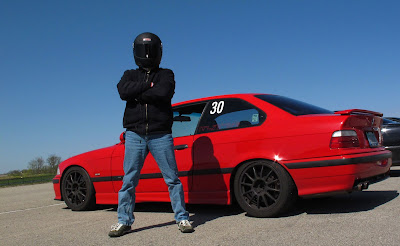Braking for a corner should be very simple:
Go like hell, stop like hell, then go like hell.
The problem is there are competing goals here.
On one hand, you want to shorten the time and distance that you’re on the brakes as much as possible. On the other hand, you really want to get back onto the gas as soon as possible to extend the upcoming straight and maximize speed.
If you’re still hard on the brakes when it’s time to turn in for the corner, you’ve got a nose-heavy car.
Much of the weight would have transferred to the front tires. That means they have to spend their grip budget on braking, leaving little grip available for cornering. The back tires are light, so if you turn abruptly, the car could spin. Even it you don’t go for a spin, with so little grip available for cornering, you’ve got to go slowly into the corner.
What to do? As in any good marriage, the answer is compromise. Ask any happy spouse - to get something, you have to give something.
We give up a little bit of time by braking just a bit earlier. This allows time for us to melt-off the brakes as we’re done. That means we manage that weight transfer back to the rear tires, giving them some grip. This also frees up more and more grip at the front end for cornering. Our entry speed can rise with the increased grip. It’s still “slow in, fast out” but the slow can be faster.
The old saw holds true: “Late braking will gain you 1/100th of a second, but getting on the gas earlier will gain you 1/10th of a second.” That’s a hundred times more time. That’s what we get for our taking a bit more time on the brakes. We get to get onto the gas sooner. Yes, “He (or she) who gets on the gas first, wins.” Another truism.
The Hard squeeze, Melt-off, Roll on (the gas), technique really works and is the mainstay in getting all of the grip available from your tires. Concentrate on smooth brake release. It’s an advanced driving skill and usually the last one mastered.
First, be sure your tires are pointed straight. Two hands on the wheel. Downshifts are last in this process. Now squeeze hard, but don’t stomp, to get to full brakes as quickly as is possible. You want to be just on the threshold of your tires locking up or the advent of ABS. Yes, this is what is meant by “threshold braking.” Stay on the brakes as you approach your turn-in point. Smoothly melt off the brake pedal. Use your toes to feel the pedals.
If you need to shift, finish melting off and downshift before turning in. If you have mastered the vanishing art of the heel-and-toe downshift, your downshift costs you no time. You can be both on the brakes and downshift at the same time. Such happy feet.
Again using your toes, begin to roll back onto the throttle. Three-time World Champion driver Jackie Steward advises “Don’t ever get on the throttle until you’re sure you don’t have to get out of it again.” Be patient and smooth. Think of both gas and brakes as dimmers to be turned smoothly. They’re not On/Off switches.
You should vary the rate you go from full brakes to full off, and from no gas to wide open throttle depending on the grip you’ve got available.
Advanced drivers even extend their braking zones into the beginning of the turns as they melt-off or trail-off the brakes. Yep, another term better understood, this is trail braking. You trail off the brakes after turning in, trading some braking grip for cornering grip.
We want novice and beginning drivers to always brake in a straight line. This allows for all of the tires’ grip to be used slowing down. Intermediate drivers learn to melt off later, and trail brake into corners. Advanced drivers do this as a matter of course.
That took longer than I thought - time for a break.
P.S. Here’s a pet peeve: the past tense of brake is braked, not broke. (Unless, of course something stopped working in the braking system) “I braked too late and missed the apex,” and not “I broke too late...”



